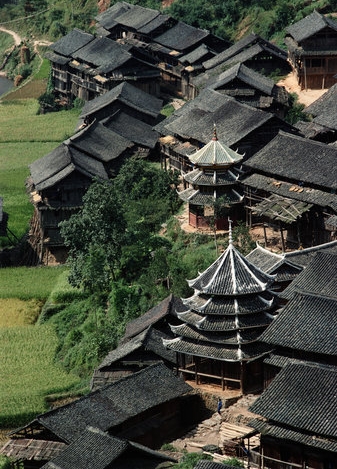They eventually called on Yang Siyu and his father for help. The pair immediately set off at the head of a logging team to the nearby mountains. There they cut down and shaped timber to replace the ravaged bridge’s thousands of missing parts, mentally calculating the size of each raft, purlin and pillar. Within two weeks they had prepared the needed timber. Without consulting the team’s carefully compiled codes, father and son then oversaw the piecing together of the salvaged parts and their splicing with the new components. It was only when the bridge stood exactly as it had for the past century that these formally-trained architects were able to finish their blueprint. This achievement brought Yang senior and junior instant fame in China’s architectural sector.

A Dong village.
Sons for Bridges
The Yangs have an affinity with the Chengyang Bridge. Yang Siyu’s grandfather, Yang Tangfu, liquidated most of his assets, including farmland, to help fund its construction.
Bridges have a special significance for residents in Sanjiang county. Local Dong residents believe that a bridge spans the river separating the temporal and nether worlds, and that contributing to bridge building brings rewards in the afterlife and blessings on offspring. This explains why the small county of Sanjiang is strewn with more than 100 bridges, and why bridge building shows no abatement.
This ancient belief turned out to be true for Yang Tangfu. The sole male heir in his family after three generations, he did not himself have a child until many years after marrying. His first son Yang Shanren was born soon after the Chengyang Bridge was completed, and his brood steadily expanded in tandem with his funding of more bridges. Yang Shanren later had five sons, two daughters and a dozen grandchildren. Of the five that inherited the family bridge building business, Yang Siyu is the most adept.
“My father felt a strong bond with the Chengyang Bridge, and would shed tears on every visit, so I refurbish it every 10 years. When the 1993 repair project ran out of government funding, I covered the shortfall by selling half of the tiles on my roof. A tarpaulin covered my home for more than a year after,” Yang Siyu recalled.
The bridge building passion has been ingrained in Dong life for millennia. The wooden structure spanning every river in their environs represents a celebration of their faith and a monument to their charitable spirit.
Mini-masterpiece
When Hong Kong was returned to China in 1997, Guangxi Zhuang autonomous region decided to present a mini replica of the Chengyang Bridge as a gift to the government of Hong Kong Special Administrative Region. On hearing the news, Yang Siyu applied to the relevant government department, telling them he was willing to carry out this task for free. Yang’s application was accepted barely one month before the delivery date. To win this race against time Yang mobilized h i s whole family, including Yang’s 75-year-old father Yang Shanren, and his teenage children. After three weeks of working day and night, stopping only for the occasional bite to eat, the Yangs came up with an exact replica of the Chengyang Bridge. Like the original, it consists of more than 9,800 parts, the longest 2.5 meters and the shortest just a few millimeters long, connected, according to tradition, solely by tenon and mortise joints. More than 100,000 millet-sized hand-carved tiles shingle its roof.
After undergoing a close scrutiny, Yang’s work achieved the highest score of all other submissions. It was then shipped to Hong Kong for an exhibition, where local architects marveled at its complexity and delicacy. One journeyed to Yang Siyu’s home to consult him on Dong architectural culture.
Yang now mentors more than 100 apprentices including his two sons. Although committed to handing down this archaic ethnic craft, he has another plan in mind for the future. An aficionado of the Dong Grand Song – unaccompanied folk acapella singing – he hopes to establish a troupe and build a theater by Chengyang Bridge with a stage on the first floor and a restaurant serving Dong food on the second. As Yang Siyu said, “It will also offer local villagers a venue to meet and enjoy theatrical entertainment.”
Source: China Today
